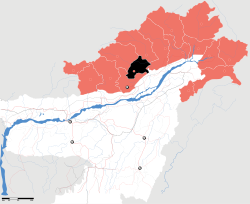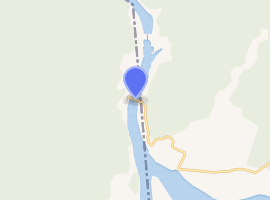Subansiri Lower Dam
The Subansiri Lower Dam, officially named Subansiri Lower Hydroelectric Project (SLHEP), is an under construction gravity dam on the Subansiri River in NorthEastern India. It is located 2.3 km (1.4 mi) upstream of Gerukamukh village in Dhemaji District and Lower Subansiri District on the border of Assam and Arunachal Pradesh. Described as a run-of-the-river project by NHPC Limited, the Project is expected to supply 2,000 MW of power when completed.[2] The project has experienced several problems during construction to include landslides, re-design and opposition. It was expected to be complete in 2018. It is notable that, if completed as planned, it will be the largest hydroelectric project in India.[3][4]
| Subansiri Lower Project | |
|---|---|
 Location of Lower Subansiri District, Arunachal Pradesh, Northeast India | |
 Location of the Subansiri Lower Dam in Arunachal Pradesh | |
| Official name | Subansiri Lower Hydroelectric Power Project (LSHEP) |
| Country | India |
| Location | Assam & Arunachal Pradesh |
| Coordinates | 27°33′13″N 94°15′31″E |
| Status | Under construction |
| Construction began | December 2007 |
| Construction cost | Rs. 62.9 billion (December 2002 est.) |
| Owner(s) | NHPC Limited |
| Dam and spillways | |
| Type of dam | Concrete gravity |
| Impounds | Lower Subansiri River |
| Height | 116 m (381 ft) |
| Height (foundation) | 130 m (427 ft) |
| Length | 284 m (932 ft) |
| Dam volume | 2,250,000 m3 (2,942,889 cu yd) |
| Spillway type | Ski jump |
| Spillway capacity | 37,500 m3/s (1,324,300 cu ft/s) |
| Reservoir | |
| Total capacity | 1.37 km3 (1,110,677 acre⋅ft) |
| Active capacity | 0.44 km3 (356,714 acre⋅ft) |
| Surface area | 33.5 km2 (13 sq mi)[1] |
| Power Station | |
| Operator(s) | NHPC Limited |
| Commission date | 2016-2018 (est.) |
| Turbines | 8 × 250 MW Francis-type |
| Installed capacity | 2,000 MW (max. planned) |
| Annual generation | 7,421 GW·h |
| Website Subansari (Lower) Project | |
As of early 2019, work was not progressing on either of the two major dam projects in the Assam region, the Dibang and the Lower Subansiri.[5]
After clearance of ‘Subansiri Lower Project’ by Hon’ble NGT vide its Order dated: 31.07.2019, Main works of the Dam has been resumed on 15.10.2019.
Design
Subansiri Lower Dam bridge | |
|---|---|
| Coordinates | 27°32′35″N 94°15′25″E |
| Carries | vehicles |
| Characteristics | |
| Total length | 150 m (492 ft) |
| Width | 150 m (492 ft) |

| |
The concrete gravity dam is designed to be 116 m (381 ft) tall, measured from the river bed and130 m (430 ft) from foundation. Its length will be 284 m (932 ft) and the dam will have a structural volume of 2,250,000 m3 (2,942,889 cu yd). The reservoir created by the dam will have a gross storage capacity of 1.37 km3 (1,110,677 acre⋅ft), of which .44 km3 (356,714 acre⋅ft) can be used for power generation or irrigation. At normal level, the reservoir's surface will cover 33.5 km2 (13 sq mi). The surface powerhouse, located on the left bank, will contain eight 250 MW Francis turbine generators.[1][2]
There will be eight horse shoe shaped head race tunnels, each being 9.5 m (31 ft) in diameter and having a length from 608–1,168 m (1,995–3,832 ft). There will be eight horse Shoe shaped surge tunnels, each being 9.5 m (31 ft) in diameter and having length from 400–485 m (1,312–1,591 ft). There will be eight horse shoe/circular shaped penstocks with varying diameters of 7–9.5 m (23–31 ft) and lengths of168–190 m (551–623 ft). The tail race channel, which will transfer water discharged by the turbines back to the river, is 206 m (676 ft) wide and 35 m (115 ft) long.[2]
Construction
Construction of Subansiri Lower Project involves many challenges. These include land not being available when construction was scheduled to commence, a limited annual construction time because of monsoons (from mid-April to mid-October), the need to handle high flood flows and poor rock conditions. The design of the dam has undergone drastic and repeated revisions that have affected the schedule and planning of the construction work.[6]
In December 2003 the contract to build the dam and its associated structures was awarded to a consortium of Boguchandgesstroy, Soyuzgidrosptsstry and Soma Enterprise Ltd. Due to difficulties acquiring land around the site, construction could not begin in earnest until 13 months after the contract was awarded. Unexpected geological conditions at the dam site led to landslides and slower tunnel excavation. By November 2007, the river was successfully diverted and in April of the next year, the foundation was clear for construction. Before the foundation was fully prepared it was discovered that bedrock was reached 10 m (33 ft) sooner than expected. This led to an alteration in the dam's design for stability. While the dam was being re-designed, concrete was placed over the foundation to protect it from the upcoming monsoon floods as the cofferdams stood a good chance of not protecting the foundation from the strong floods. The re-design was completed in October 2008 and soon after the foundation was once again cleared. In May 2009, work was suspended because of the monsoon season and re-commenced in November of that year.[6]
As of November 2011, the dam reached an elevation of 138 m (453 ft), just below the spillway elevation of 145 m (476 ft). On 16 December 2011, construction equipment was halted by protests.[7]
The construction cost has gone up by about ₹1,200 crore owing to forced suspension of work since December 2011. NHPC has already spent about ₹6,600 crore, according to a status report prepared by the company.[8]
Commissioning of the first generator is loosely expected to occur in 2016 with the final generator in 2018.[9]
Environmental impact
Some environmental impacts unique to very large dams will result from completion of the Subansiri Project, both upstream and downstream of the dam site. These impacts will include ecosystem damage and loss of land.
The reservoir of the Subansiri Project will submerge a 47 km (29 mi) length of the Subansiri river and occupy 37.5–40 km2 (14.5–15.4 sq mi) which includes Himalayan subtropical pine forests, Himalayan subtropical broadleaf forests, part of the Tale Valley Wildlife Sanctuary, an elephant corridor and some subsistence agriculture fields.[10]
Thirty eight families will be displaced if the dam is completed, according to official data.[11]
- Downstream
Water flow downstream will be regulated by the dam which is expected to result in low releases (6 m3/s) during winter and very high releases (2,560 m3/s) when energy is being generated.[12]
The project has met stiff resistance from several groups including All Assam Students’ Union and the Krishak Mukti Sangram Samiti, who are apprehensive about safety and the project’s downstream impact.[8]
References
- "India: National Register of Large Dams 2009" (PDF). Central Water Commission. Archived from the original (PDF) on 21 July 2011. Retrieved 10 July 2011.
- "Welcome to Subansiri (Lower) Project". NHPC India. Retrieved 12 March 2012.
- "'Construction of Subansiri dam not to be stopped'". Times of India. Bennett, Coleman & Co. Ltd. 16 February 2012. Retrieved 9 March 2012.
- "Subansiri dam work not to be halted: Ramesh". The Assam Tribune. 12 August 2010. Retrieved 28 August 2010.
- Talukdar, Sandipan (28 November 2018). "Big Dams in Arunachal-Assam Border likely to Resume Work after NGT Green Signal". NewsClick. Retrieved 27 December 2018.
- Biswajit Das (2011). "Planning and Building the Subansiri Lower Dam and Hydro Project". HydroWorld. PennWell Corporation. Retrieved 7 March 2012.
- Tanmoy Sharma. "Fighting India's mega dams". The Third Pole. China Dialogue. Retrieved 7 March 2012.
- "Subansiri Project dispute to be resolved through negotiations". IANS. news.biharprabha.com. Retrieved 6 July 2014.
- "Status of Hydro Electric Projects under Execution for 12th Plan & beyond" (PDF). Central Electric Authority - India. 31 March 2014. Archived from the original (PDF) on 15 July 2014. Retrieved 9 July 2014.
-
"Lower Subansiri: NHPC had to pay Rs 3 B for forestland" (PDF). Dams, Rivers & People. SANDRP. 2-issue 9-10-11: 12. Oct, Nov, Dec 2004. Retrieved 9 March 2012. Check date values in:
|date=(help) - Diana Vinding (2004). The Indigenous World 2004. Copenhagen: Eks-Skolens Trykkeri. p. 323. ISBN 87-90730-83-6. ISSN 0105-4503. Retrieved 9 March 2012.
- "People's Power Blocks Dam Construction in Northeast India". Tag Archive for 'Subansiri Dam'. Peakwater. 5 December 2011. Retrieved 9 March 2012.